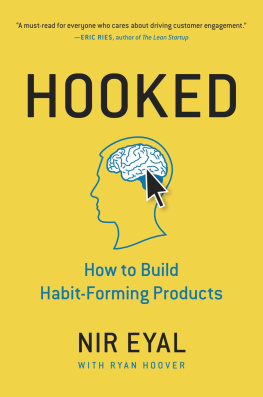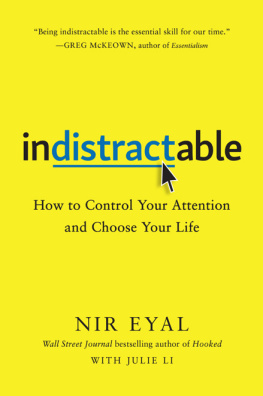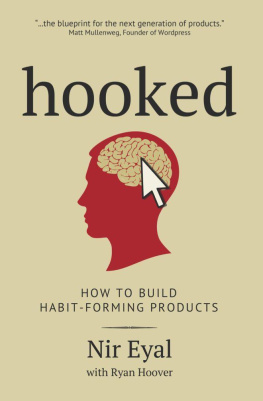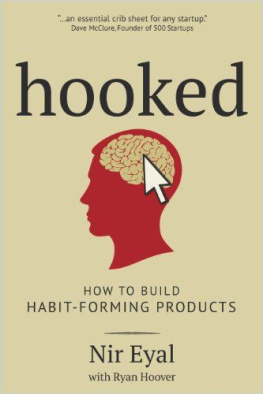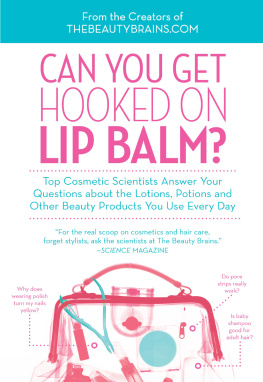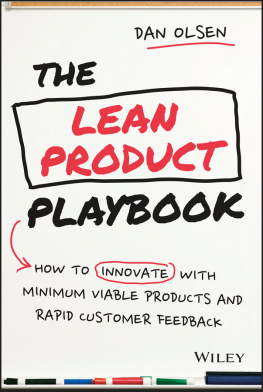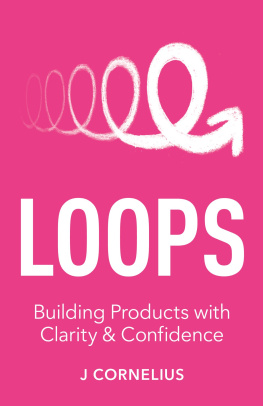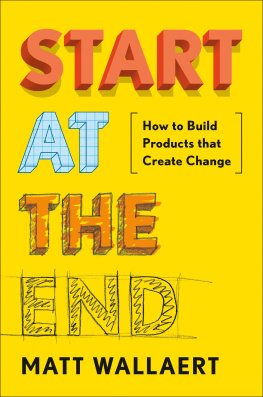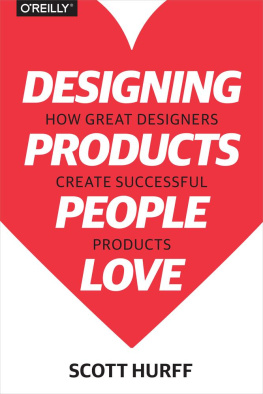USA | Canada | UK | Ireland | Australia | New Zealand | India | South Africa | China
Penguin supports copyright. Copyright fuels creativity, encourages diverse voices, promotes free speech, and creates a vibrant culture. Thank you for buying an authorized edition of this book and for complying with copyright laws by not reproducing, scanning, or distributing any part of it in any form without permission. You are supporting writers and allowing Penguin to continue to publish books for every reader.
Eyal, Nir.
Hooked : how to build habit-forming products / Nir Eyal with Ryan Hoover.
Includes bibliographical references.
1. New products. 2. Consumer behavior. 3. Consumers preferences. I. Title.
introduction
Seventy-nine percent of smartphone owners check their device within fifteen minutes of waking up every morning.
A 2011 university study suggested people check their phones thirty-four times per day.
Face it: Were hooked.
The technologies we use have turned into compulsions, if not full-fledged addictions. Its the impulse to check a message notification. Its the pull to visit YouTube, Facebook, or Twitter for just a few minutes, only to find yourself still tapping and scrolling an hour later. Its the urge you likely feel throughout your day but hardly notice.
Cognitive psychologists define habits as automatic behaviors triggered by situational cues: things we do with little or no conscious thought. Our actions have been engineered.
How do companies, producing little more than bits of code displayed on a screen, seemingly control users minds? What makes some products so habit forming?
Forming habits is imperative for the survival of many products. As infinite distractions compete for our attention, companies are learning to master novel tactics to stay relevant in users minds. Amassing millions of users is no longer good enough. Companies increasingly find that their economic value is a function of the strength of the habits they create. In order to win the loyalty of their users and create a product thats regularly used, companies must learn not only what compels users to click but also what makes them tick.
Although some companies are just waking up to this new reality, others are already cashing in. By mastering habit-forming product design, the companies profiled in this book make their goods indispensable.
FIRST TO MIND WINS
Companies that form strong user habits enjoy several benefits to their bottom line. These companies attach their product to internal triggers . As a result, users show up without any external prompting.
Instead of relying on expensive marketing, habit-forming companies link their services to the users daily routines and emotions. A habit is at work when users feel a tad bored and instantly open Twitter. They feel a pang of loneliness and before rational thought occurs, they are scrolling through their Facebook feeds. A question comes to mind and before searching their brains, they query Google. The first-to-mind solution wins. In chapter 1 of this book, we explore the competitive advantages of habit-forming products.
How do products create habits? The answer: They manufacture them. While fans of the television show Mad Men are familiar with how the ad industry once created consumer desire during Madison Avenues golden era, those days are long gone. A multiscreen world of ad-wary consumers has rendered Don Drapers big-budget brainwashing useless to all but the biggest brands.
Today, small start-up teams can profoundly change behavior by guiding users through a series of experiences I call hooks . The more often users run through these hooks, the more likely they are to form habits.
How I Got Hooked
In 2008 I was among a team of Stanford MBAs starting a company backed by some of the brightest investors in Silicon Valley. Our mission was to build a platform for placing advertising into the booming world of online social games.
Notable companies were making hundreds of millions of dollars selling virtual cows on digital farms while advertisers were spending huge sums of money to influence people to buy whatever they were peddling. I admit I didnt get it at first and found myself standing at the waters edge wondering, How do they do it?
At the intersection of these two industries dependent on mind manipulation, I embarked upon a journey to learn how products change our actions and, at times, create compulsions. How did these companies engineer user behavior? What were the moral implications of building potentially addictive products? Most important, could the same forces that made these experiences so compelling also be used to build products to improve peoples lives?
Where could I find the blueprints for forming habits? To my disappointment, I found no guide. Businesses skilled in behavior design guarded their secrets, and although I uncovered books, white papers, and blog posts tangentially related to the topic, there was no how-to manual for building habit-forming products.
I began documenting my observations of hundreds of companies to uncover patterns in user-experience designs and functionality. Although every business had its unique flavor, I sought to identify the commonalities behind the winners and understand what was missing among the losers.
I looked for insights from academia, drawing upon consumer psychology, human-computer interaction, and behavioral economics research. In 2011 I began sharing what I learned and started working as a consultant to a host of Silicon Valley companies, from small start-ups to Fortune 500 enterprises. Each client provided an opportunity to test my theories, draw new insights, and refine my thinking. I began blogging about what I learned at NirAndFar.com, and my essays were syndicated to other sites. Readers soon began writing in with their own observations and examples.
In the fall of 2012 Dr. Baba Shiv and I designed and taught a class at the Stanford Graduate School of Business on the science of influencing human behavior. The next year, I partnered with Dr. Steph Habif to teach a similar course at the Hasso Plattner Institute of Design.
These years of distilled research and real-world experience resulted in the creation of the Hook Model: a four-phase process companies use to forms habits.
Through consecutive Hook cycles, successful products reach their ultimate goal of unprompted user engagement, bringing users back repeatedly, without depending on costly advertising or aggressive messaging.
While I draw many examples from technology companies given my industry background, hooks are everywherein apps, sports, movies, games, and even our jobs. Hooks can be found in virtually any experience that burrows into our minds (and often our wallets). The four steps of the Hook Model provide the framework for the chapters of this book.

